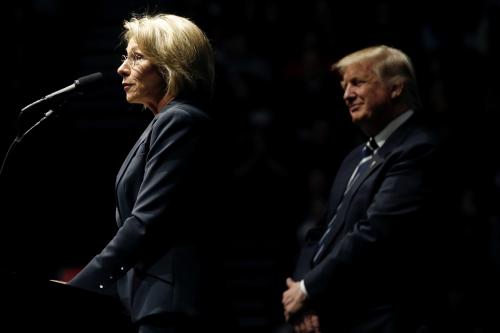Last week, the Trump administration’s departments of Justice and Education formally rescinded guidance issued by the Obama administration on the treatment of transgender students and their rights to access sex-segregated spaces, including bathrooms and locker rooms, in public schools. The previous guidance stated plainly that Title IX, the 1972 law that prohibits sex discrimination in federally funded education, also protects transgender students. The guidance also directed school districts to, among other protections, allow transgender students to use school facilities in accordance with their gender identity.
By withdrawing this guidance, the Trump administration has declared its belief that this question–how school districts should treat transgender students, and what spaces they should be allowed to access–be addressed at the state or school district level.
Trump’s rescission of the earlier guidance creates confusion rather than clarity about the enforcement of transgender students’ rights under Title IX. The potential implications of this decision include a shifting patchwork of protections for transgender students in some school districts or states but not in others, and an increasingly critical Supreme Court case (Gloucester County School Board v. G.G.) over the meaning of sex discrimination in modern America.
Transgender discrimination as sex discrimination
In 1989, the Supreme Court ruled that discrimination based on non-conformance with gender norms, stereotypes, and other sex-based considerations constitutes illegal sex discrimination under Title VII of the Civil Rights Act of 1964 (Price Waterhouse v. Hopkins). Since at least 2000, courts and federal agencies have applied that precedent to protections for transgender people, who often defy others’ stereotypes or expectations of how a person of a particular sex or gender should look, dress, or act. Numerous courts (including the 4th, 6th, 9th, and 11th Circuits, and the District Court of D.C.) and federal agencies (including the Equal Employment Opportunity Commission and the Department of Health and Human Services) have agreed that discriminating against transgender (and LGB) people is discriminating on the basis of gender stereotypes or expectations, and is therefore illegal sex discrimination.
In recent years, as transgender people became more visible–particularly among younger age groups–schools around the country were engaging more directly with the question of how best to accommodate transgender students. At the requests of many schools districts and colleges, the Obama administration issued its original guidance to provide nationwide clarity regarding Title IX on this matter. That guidance was consistent with and bolstered by the aforementioned court rulings around the country.
The key takeaway here is that the protections for transgender students did not spring into existence because of the Obama guidance; rather, the Obama guidance codified existing protections provided by Title IX. As a result, schools around the country continue to have a legal obligation to protect these students’ rights, including equal access to facilities consistent with their gender identity, even following the guidance’s withdrawal.
Bathrooms are a focal point in civil rights history
While this focus on bathrooms as a “frontier” of transgender rights may seem new to some, it comes as no surprise to civil rights advocates. Bathrooms have historically been a place where Americans express cultural anxieties (and prejudice) about minority groups, including in the contexts of racial (de)segregation, women’s suffrage, and the Equal Rights Amendment. Similarly, delegating issues of discrimination to the state level follows a long history. Opponents of desegregation, interracial marriage, and marriage equality also argued for letting states decide these issues.
Additionally, my own research shows that many people still feel disgust toward LGBTQ people, and particularly so toward transgender people. People typically want to avoid close contact with those they dislike or find disgusting; given the intimacy of sex-segregated spaces such as bathrooms and locker rooms, it is no surprise that some people are expressing strong reactions to the possibility of knowingly sharing space with transgender people. However, young people hold considerably more positive attitudes toward transgender people, meaning that the current cultural anxiety around transgender students’ (and people more generally) access to bathrooms stems from adults, not students themselves.
The next gay marriage?
Though the Title IX protections for transgender students remain in law, Trump’s withdrawal of the Obama guidance likely means that in practice, transgender students and their families will face widely different experiences from one school district to the next. By delegating this issue to states and localities, the Trump administration is effectively providing cover for schools to decide for themselves how or whether to accommodate transgender students.
As gay marriage advocates experienced before marriage was legalized nationwide in 2015, a geographic patchwork of protections–where one’s legal rights vary from state to state–is a recipe for confusion, contradiction, and legal battles. Such patchworks create uncertainty among both institutions and individuals as to their obligations and rights, lead to negative health outcomes for LGBTQ people, and restrict mobility and reduce economic opportunity for all. Research has also shown the similarly negative impacts of misgendering, bathroom policing, and discrimination on transgender people. One need not look further than North Carolina to see negative economic effects of such treatment codified in policy.
Recent research also shows the relationship between state-level same-sex marriage bans and suicide attempts among sexual minority (i.e., LGBTQ) youth; imagine the impact of policies designed to target the youth specifically, rather than their adult counterparts. Imagine this further given the already shockingly high rates of suicide attempts among transgender and gender non-conforming people–nearly nine times that of the general U.S. population.
A looming Supreme Court battle
The withdrawal of this guidance also increases the importance of what was already expected to be a key Supreme Court case and potential (legal) turning point for the transgender rights movement. In Virginia, a young transgender man named Gavin Grimm was originally allowed, and then later denied access to the men’s room at his high school. He filed suit against the school district; that case, Gloucester County School Board v. G.G., is now before the Supreme Court, awaiting arguments scheduled for later this month.
At the heart of this case is the fundamental question that will at least partially determine (from a legal perspective) the future course of the transgender rights movement: Do sex discrimination protections include transgender people? Though Grimm’s case refers specifically to Title IX (i.e., education) protections, an affirmative court decision would profoundly improve the legal footing of transgender people around the country, and their claims to legal protections against discrimination in many aspects of American life. If the court decides otherwise, the precedent could weaken similar claims to protection made in other contexts (e.g., sex protections in employment under Title VII). Transgender advocates could still pursue different paths to legal protections, such as directly appealing to equal protection under the 14th Amendment. However, this would be a setback to advocates, who for years have been pursuing the legal agenda of establishing the idea that transgender discrimination constitutes illegal sex discrimination.
The increased importance of the Grimm case also highlights the stakes of Judge Neil Gorsuch’s nomination to the Supreme Court. Gorsuch has in the past issued decisions rejecting the discrimination claims of and denying needed medical care to transgender people. If confirmed, he would likely not be an ally to LGBTQ people in this or in future decisions.
What comes next?
Title IX and the protections it affords are still in place, though the enforcement of these rights is now in question. If the Trump administration intends to delegate the issue to states and localities, as it has stated, then advocacy organizations on both sides will likely increase their focus on connecting with and mobilizing parents, who are clearly an important constituency to local school boards and policymakers. Those opposed to providing protections for transgender people will likely increase their current efforts to establish religious freedom protections or exemptions from existing LGBTQ protections. They can also be expected to continue stoking ungrounded fears about transgender people in bathrooms, as they have in Houston, for example, and in opposition to historical efforts more generally to gain rights for both gay and transgender people.
Moving forward, LGBTQ advocates will likely focus in particular on parents and allies of transgender and gender non-conforming youth to petition their local school districts and advocate for the strongest protections possible. This move will come as part of a broader, already in-progress agenda to educate the public about the lives and experiences of transgender people on their own terms and in their own voices. Such public education efforts will be necessary to spur a cultural shift on attitudes toward transgender people, especially given how many fewer people know a transgender person compared to those who know a gay or lesbian person.
In the meantime, some states may recognize transgender students’ rights under Title IX, while others will likely not. Policymakers and educators responsible for making these decisions owe it to all students to educate themselves about the consequences of their decisions and their impact on children throughout the country.
The Brookings Institution is committed to quality, independence, and impact.
We are supported by a diverse array of funders. In line with our values and policies, each Brookings publication represents the sole views of its author(s).







Commentary
After Trump rescinds Title IX guidance, what’s next for transgender students’ rights?
March 1, 2017